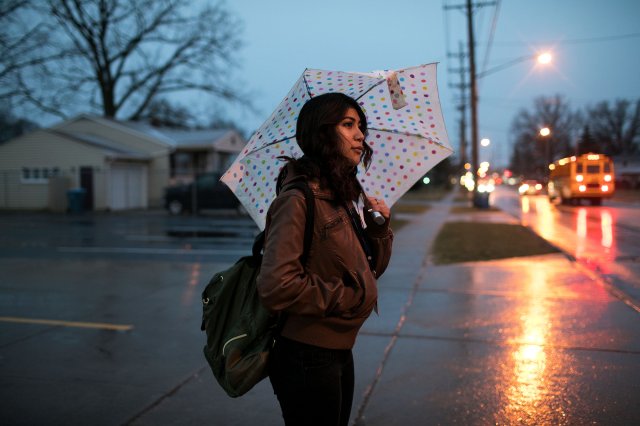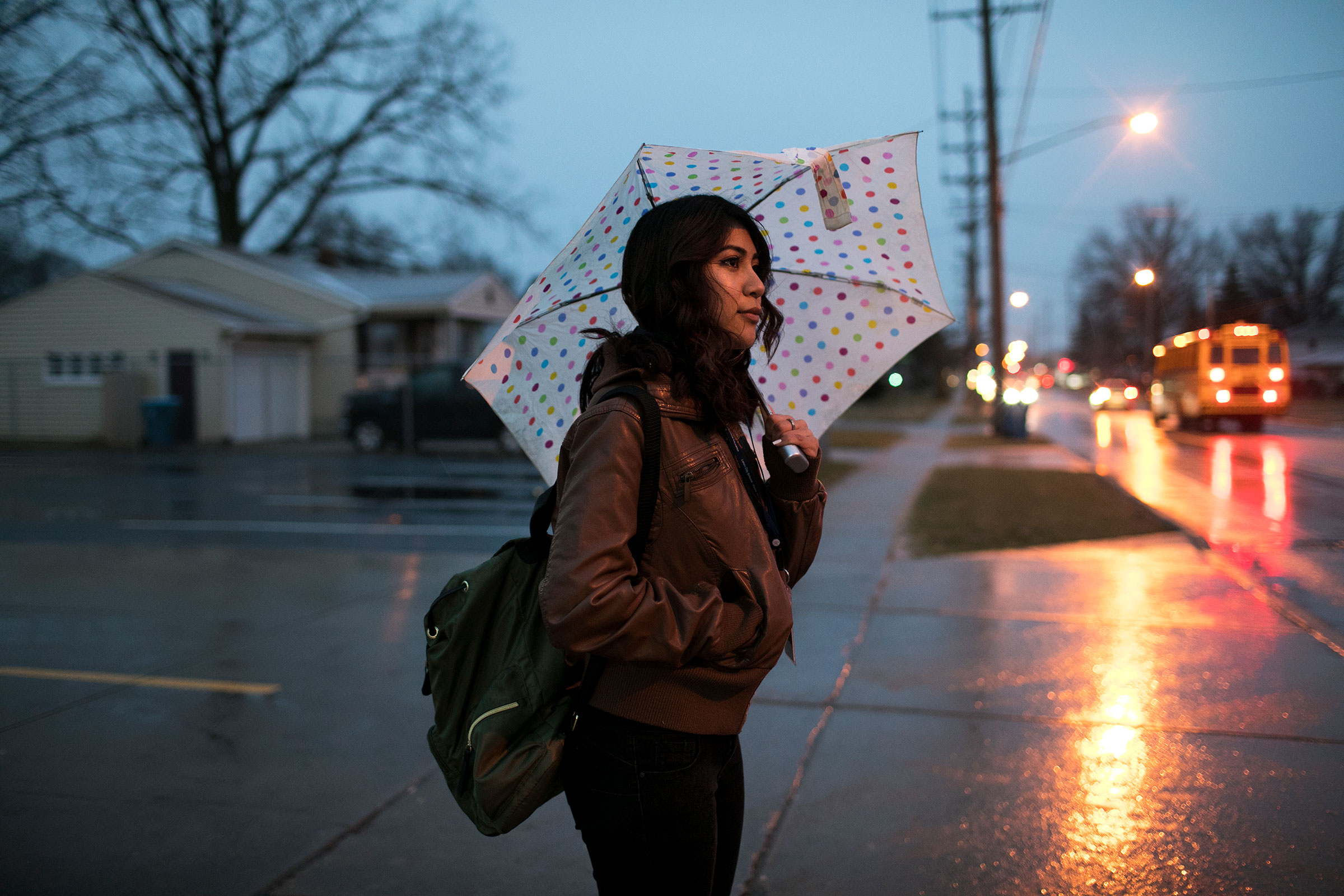A Dreamer’s Life
Corina Barranco starts each American day the same way she started her American life: by putting one foot in front of another. Thirteen years ago, when she was 5, she walked across the Mexican border into Arizona. On this Thursday in February, Barranco leaves her home in Lorain, Ohio, at 6:50 a.m. to walk through swirling snow, under purple predawn skies, past empty houses where she suspects drugs are sold. Her family does not have a car, so Barranco’s feet take her from school to work to church across this fading industrial city, between a tangle of highways, on streets that lack sidewalks. Even when there is a hole in her boot, she is rarely late.
By 7:23, the high school senior is sitting in the front row of her computer class, plowing through brain puzzles. It’s busy work, the kind of low-stakes activity that most kids skip when there’s a substitute teacher, which is what they have today. A few seats down, a boy is playing video games and watching YouTube. Then the loudspeaker crackles and the voice of the principal fills the room. Barranco stands, hand on her heart; she turns toward the flag and recites the Pledge of Allegiance.
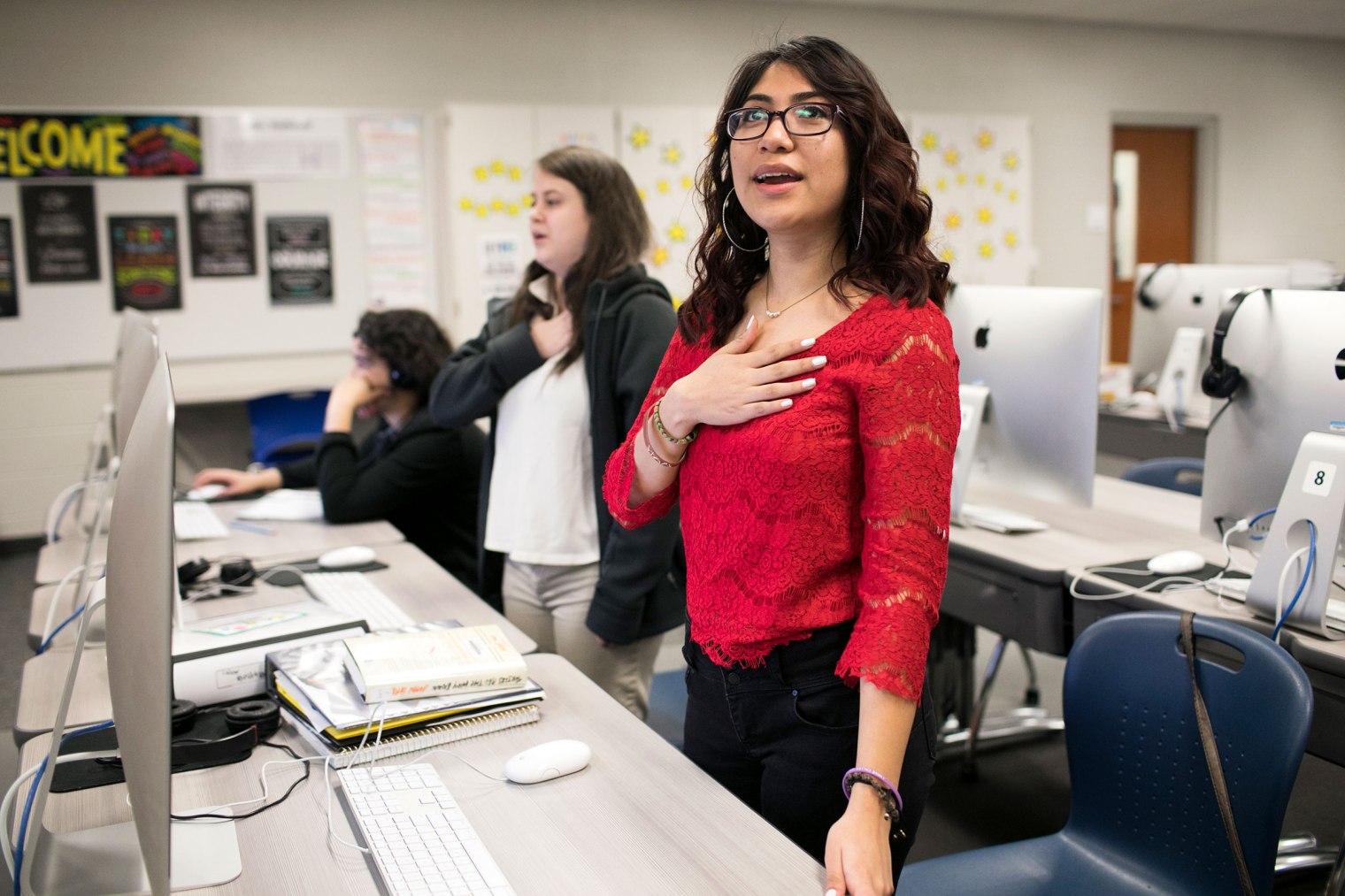 Corina Barranco says the pledge of allegiance at Lorain High School in Lorain, Ohio, on Feb. 22, 2018. Barranco, a senior, is a Dreamer and one of nearly 800,000 young immigrants with DACA status.
Corina Barranco says the pledge of allegiance at Lorain High School in Lorain, Ohio, on Feb. 22, 2018. Barranco, a senior, is a Dreamer and one of nearly 800,000 young immigrants with DACA status.
Barranco has lived in the U.S. since 2005, when she and a family member walked for more than a week to cross the border into Arizona. Barranco remembers getting new Converse sneakers with Barbie on them. She remembers walking for days without food and being carried on the backs of her traveling companions. She remembers seeing cows drink out of a puddle and then lowering her own face to drink the same water. She remembers digging through a trash can to find her first bite of food in three days, a small bag of Oreos, and lying on the floor of a red car and resting her head on men’s boots. She remembers that upon her arrival in Arizona, someone tried to feed her fried chicken, but her throat was too dry to eat it.
Barranco is one of some 700,000 young people in the U.S. who are shielded from deportation by the Deferred Action for Childhood Arrivals (DACA) program. Enacted by President Obama, it gave legal protections to those brought to the U.S. illegally as children—a group dubbed the Dreamers. But in September, Attorney General Je Sessions announced that the Trump Administration would rescind DACA on March 5, nominally buying Congress time to renegotiate the program. The result has been predictably messy, ensnaring all three branches of government. Immigration advocates sued, and a federal judge blocked the Trump Administration from ending DACA while the lawsuits proceed. The Supreme Court has declined to step in.
Congressional leaders from both parties have tried to find consensus. A bipartisan deal failed in the Senate, earning just eight Republican votes as the White House campaigned to kill it. (President Trump’s favored alternative won just 39 votes.) DACA has not ended as promised, but the courtordered stay means Congress lost a deadline that could have spurred action to fix the program. Trump has not ordered much help or clarity; after urging Congress to pass a law protecting the Dreamers, he has rejected multiple DACA deals, including one that would have given him money for his border wall. Yet in recent weeks he has taken to blaming Democrats for the quagmire. “DACA is dead because the Democrats didn’t care or act,” Trump tweeted April 2.
Barranco doesn’t know any of this. She has never heard of Sessions and she doesn’t have Twitter. All she knows is that her DACA was just renewed, allowing her to stay in the country for two more years that will be fraught with anxiety if a per manent solution can’t be found. “It feels like boom, boom in my chest. I get pan icky,” she says over lunch. “If they take away DACA, I won’t be able to work at McDonald’s. Immigration has my records. What if they come to get me?”
She calms herself down by forcing a smile and counting her blessings. Her family may not have a car, or a computer, or a way to pay for her to go to college. But they are together, she reminds herself, and they are in America. She has her teachers and her church in her corner. She twists her purity ring around her finger and tells herself that God is with her.
“If I’d stayed [in Mexico], I’d be working in the fields right now. Even if I don’t have the benefits of my peers, I truly am blessed. I have things I never would have had,” she says. “Like a bed.”
Barranco, who is short and cheerful, says she has only two friends, but that’s not exactly true. Kids say hello when she sits down in class and ask to work with her on projects. As she walks through the corridor at Lorain High School, a skinny boy stops in front of her, says “Hi!” and then blushes and flees. She passes a couple making out in the hallway and mutters, “Ew, get a room!”
Barranco walks into her college-readiness class on time, as always, and takes a seat alone in the front row. “I usually sit by myself,” she says. “I try to concentrate more.” For a long time, she had been fixed on a clear goal: to join the Army. Then, in her junior year, a military recruiter told her that only U.S. citizens could serve. (The military makes a few exceptions for immigrants with special skills.) Then last year, Barranco was invited to participate in a local Citizens Police Academy program. After meeting Lorain’s chief of police, she decided she wanted to be a cop.
College acceptance letters are posted on the classroom wall, next to a picture of Barranco with Chief Cel Rivera. The teacher projects a list of scholarships and orders the students to write them down. Barranco writes down the names of the scholarships in neat pink handwriting, even though she knows she’s eligible for virtually none of them. They all require FAFSA, the Free Application for Federal Student Aid that Barranco is afraid to use. DACA students are not eligible for federal aid, and although Barranco has a Social Security number and can use the federal application to apply for state and local scholarships, she’s worried that using FAFSA at all could risk her DACA status.
Several teachers urged her to apply to Oberlin College, a prestigious liberal arts school in Ohio that offers generous financial aid to undocumented students. Yet Barranco doesn’t want to. She has a 4.0 grade point average and is in the National Honor Society, but she struggled with the ACT test; she didn’t like the math, or the pressure of being timed, and she couldn’t afford private tutoring. Once she realized the ACT couldn’t help her get a scholarship anyway, she gave up trying to improve her scores. “My classmates, if they get a good ACT score, they qualify for scholarships,” she says. “For me, what’s the point?” Besides, Barranco thinks of Oberlin as a school for kids who study music. Her dream is to go to Lorain County Community College, which has a criminal justice program that could prepare her for the police academy.
Teachers want to help Barranco: they’ve written her recommendations, given her tips for filling out paperwork, and even offered to introduce her to admissions officers. But in the labyrinthine system of scholarships, aid and work-study programs, DACA students occupy a gray area: they have Social Security numbers but can’t get federal assistance, which means it’s difficult to figure out which scholarships they’re eligible for and where they’d have to shoulder the full burden. Even some administrators at Lorain Community College don’t know whether DACA students are eligible for local tuition pricing. “Having to teach kids about all of the opportunities available to them but realizing that some of them might not have the same opportunities, it’s really frustrating,” says Roxanne Ocasio, who teaches Barranco’s college-readiness class. “I sometimes sit in my office and cry.”
Immigration advocates say that even though DACA recipients can’t receive federal aid, the program has made it much easier to get a college education. Sixteen states allow DACA students to pay in-state tuition at state universities; major scholarship funds like TheDream.us help Dreamers foot the tab for tuition (Amazon founder Jeff Bezos recently donated $33 million), and DACA allows students to work jobs and earn money. According to a University of California study in collaboration with the immigrant-advocacy group United We Dream and the left-leaning Center for American Progress, 45% of DACA recipients are in school, and nearly three-quarters of those are pursuing a bachelor’s degree or higher. Of the group that isn’t currently in school, many have already graduated. “Before DACA, we didn’t have that financial support, and we weren’t able to work to put ourselves through school,” says Bruna Bouhid of United We Dream. “Without DACA, we’re back to square one.”
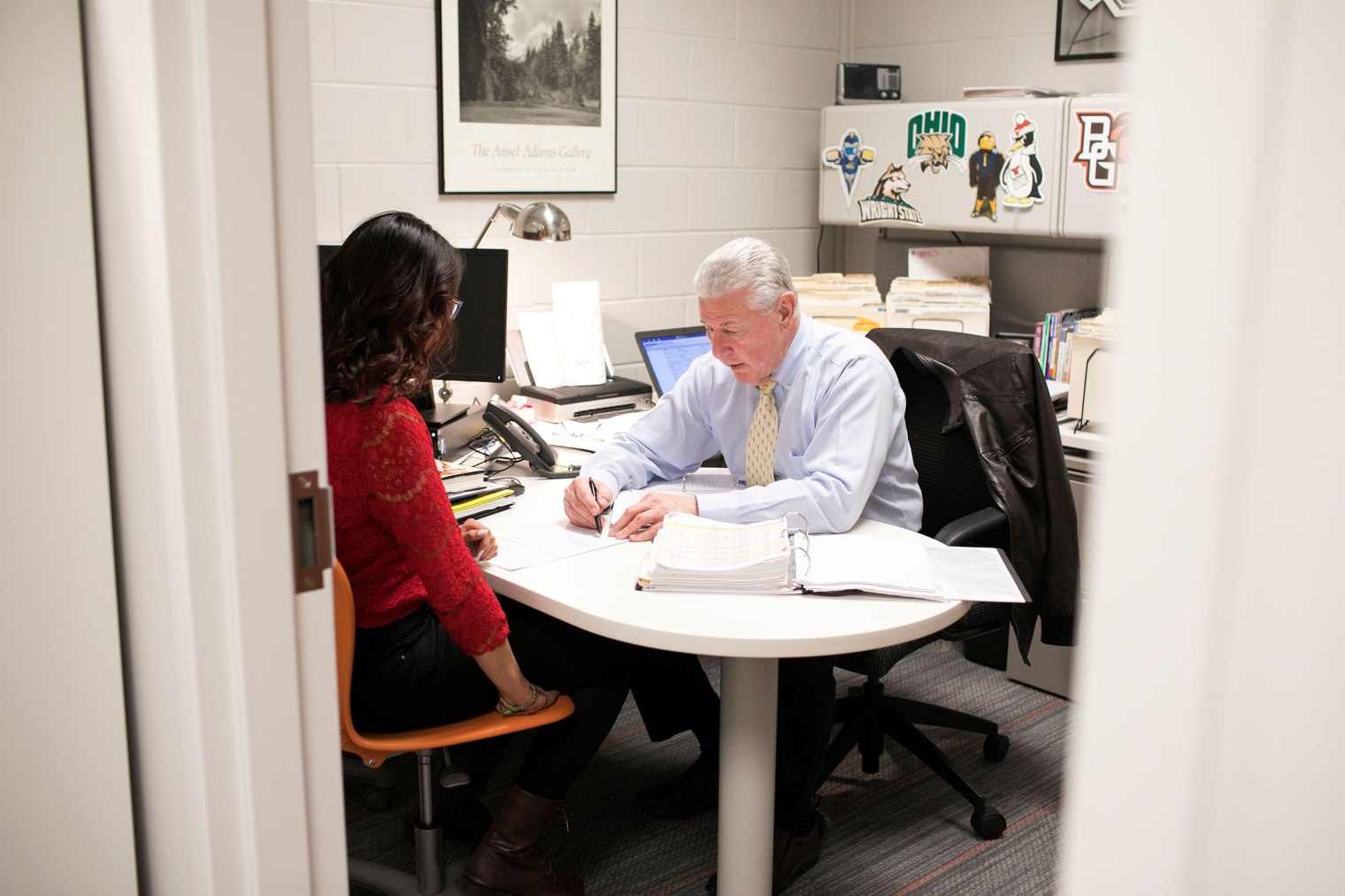 Corina Barranco meets with Dave Newman to discuss college scholarship options.
Corina Barranco meets with Dave Newman to discuss college scholarship options.
Back in class, Barranco is quietly flipping through index cards, memorizing common college terms like “admission” and “undergraduate” and “commencement.” The group next to her is goofing off; someone has dropped their index cards on the floor. Barranco stays focused and says nothing. But it bothers her. “I feel like it’s not fair. When I see that my classmates don’t take their education seriously, it makes me sad,” she says outside of class. “If they only knew what I would give to be in their shoes.”
The bell rings, and Barranco shuffles into the hall, which has become a crush of teenagers. It’s 10:38 a.m. and lunch is served, which means the hallways smell of smushed Wonder Bread, chicken fingers and reheated pizza. She heads to the cafeteria, where she waits in line to buy her cap-and-gown package — nearly $300 that will come out of her McDonald’s paycheck. She wants to buy a sweatshirt featuring the school mascot, the Titans, but the least expensive option is $30. She walks away without it. The cap and gown alone cost more than she wants to spend. Throughout the day she will bring up the sweatshirt, wondering if the vendors will be back next week. Maybe she could buy it then.
Barranco’s two best friends are Maria and Mercedes, sisters who also have DACA. Maria is in Barranco’s class; Mercedes graduated last year. (TIME agreed to withhold their last names out of concern for their immigration status.) When they’re not at church with Barranco, the sisters spend much of their time watching YouTube makeup tutorials, which means they have perfectly sculpted eyebrows and elaborate plans for future looks they want to try. Not at prom, though. None of their parents will allow them to go. “I want to dress up,” Maria says. “You would just sit there and stare at people,” Mercedes shoots back. Maria has already figured out how she would do her makeup if she ever went: a turquoise color palette, with sparkly accents.
“It’s too much money,” Barranco says with a flick of her hand, dismissing the idea of prom as she recalls the price of her graduation robes. She pays her own phone bill, and her braces cost her $6,000, which she paid out of pocket by helping her mom clean houses. “I want to experience how it feels to get all pretty and dolled up, to have a date and dance with your friends,” she says, finally. “But I have other stuff to worry about.” Her parents want her to stay home: they’re worried she’ll mix with kids who are trouble, who smoke weed or drink beer. One ordinary teenage misstep could cost the family everything. Even though Barranco cuts through the Lorain Titans’ football stadium every morning on her way to school, she’s never been to a game.
Instead, Barranco mostly stays at home, reading John Green novels or watching TV shows of Bible stories. She hasn’t seen the latest movies — her favorite actor is Tom Hanks — and the theater is too far to walk. She hears stories about things that happen at parties she doesn’t go to, and she rolls her eyes and pretends she doesn’t care. “My mom is always like, ‘You have to be more careful than the rest,’” she says. “I’m just staying in the house and life is passing before my eyes.”
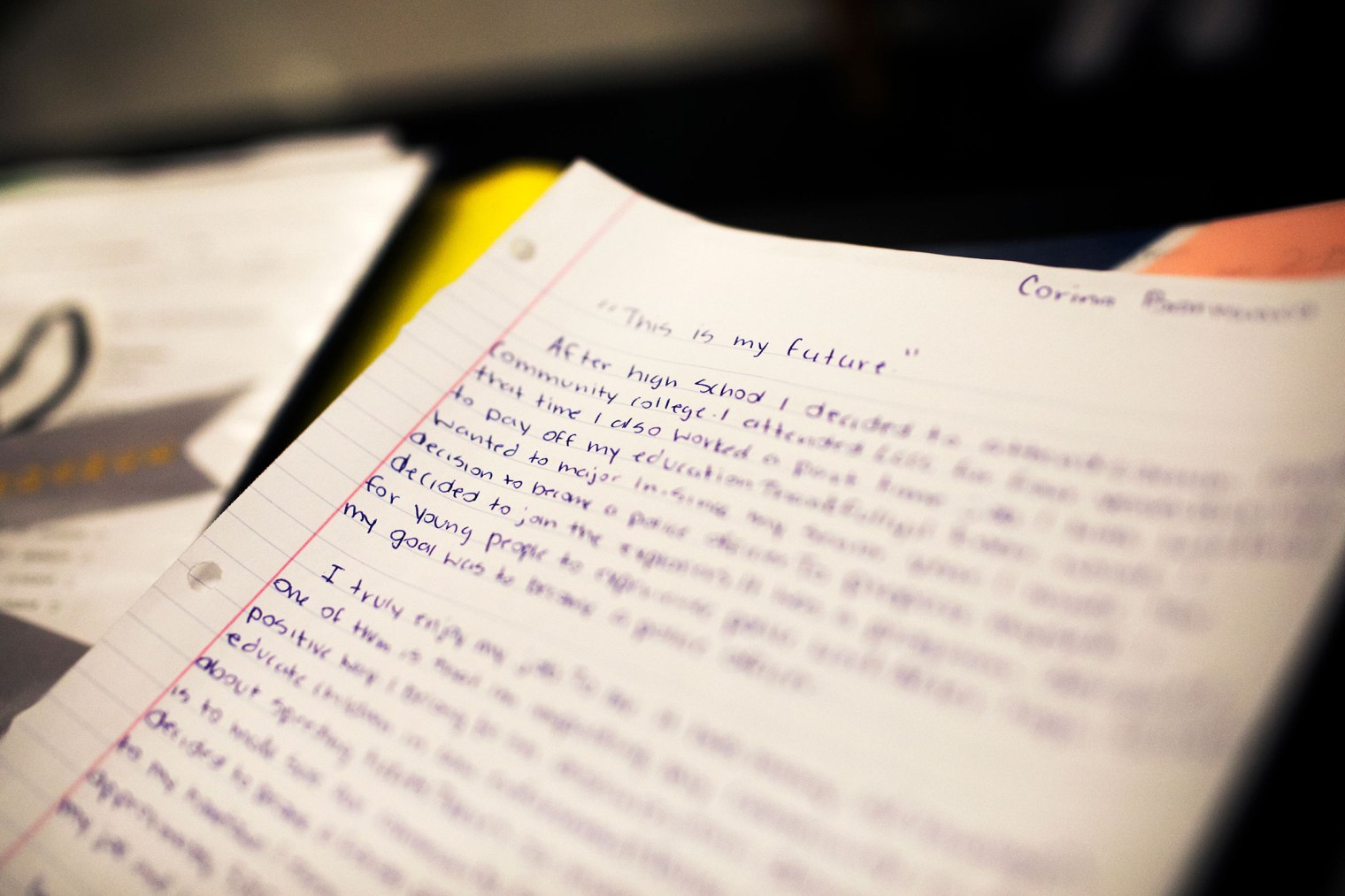 Details of an essay entitled “This is My Future,” by Corina Barranco.
Details of an essay entitled “This is My Future,” by Corina Barranco.
After school, Barranco walks almost a mile to the McDonald’s where she works. It takes her about 25 minutes, which is better than her walk to her old job at a diner, which took two hours round-trip. She was hired at McDonald’s in November, and she spends her shift making French fries and handing out burgers and sodas through the drive-through window. Her smile at the customers is genuine: she likes her gray uniform, she likes the people she works with, and she likes the $8.15 an hour she makes. She’s saving up to buy a car.
Most Dreamers work. About 90% of DACA recipients are employed, according to the 2017 University of California study; 69% said the program’s work permit helped them find a job with better pay. About 8% of DACA recipients over 25 say they’ve started their own businesses, which outpaces the rate of entrepreneurship among Americans overall. Tom K. Wong, an associate professor at the University of California San Diego who has been studying Dreamers since 2012 and co-authored the study, says that, overall, DACA has been “an integration success story.”
The best parts of Barranco’s job, she says, are when she’s called on to translate for a customer who speaks only Spanish. “I know what it’s like to be new somewhere, to not speak English, to not see a friendly face,” she says. “They need help, and I like that I’m able to help them, even if it’s just at a fast-food restaurant.”
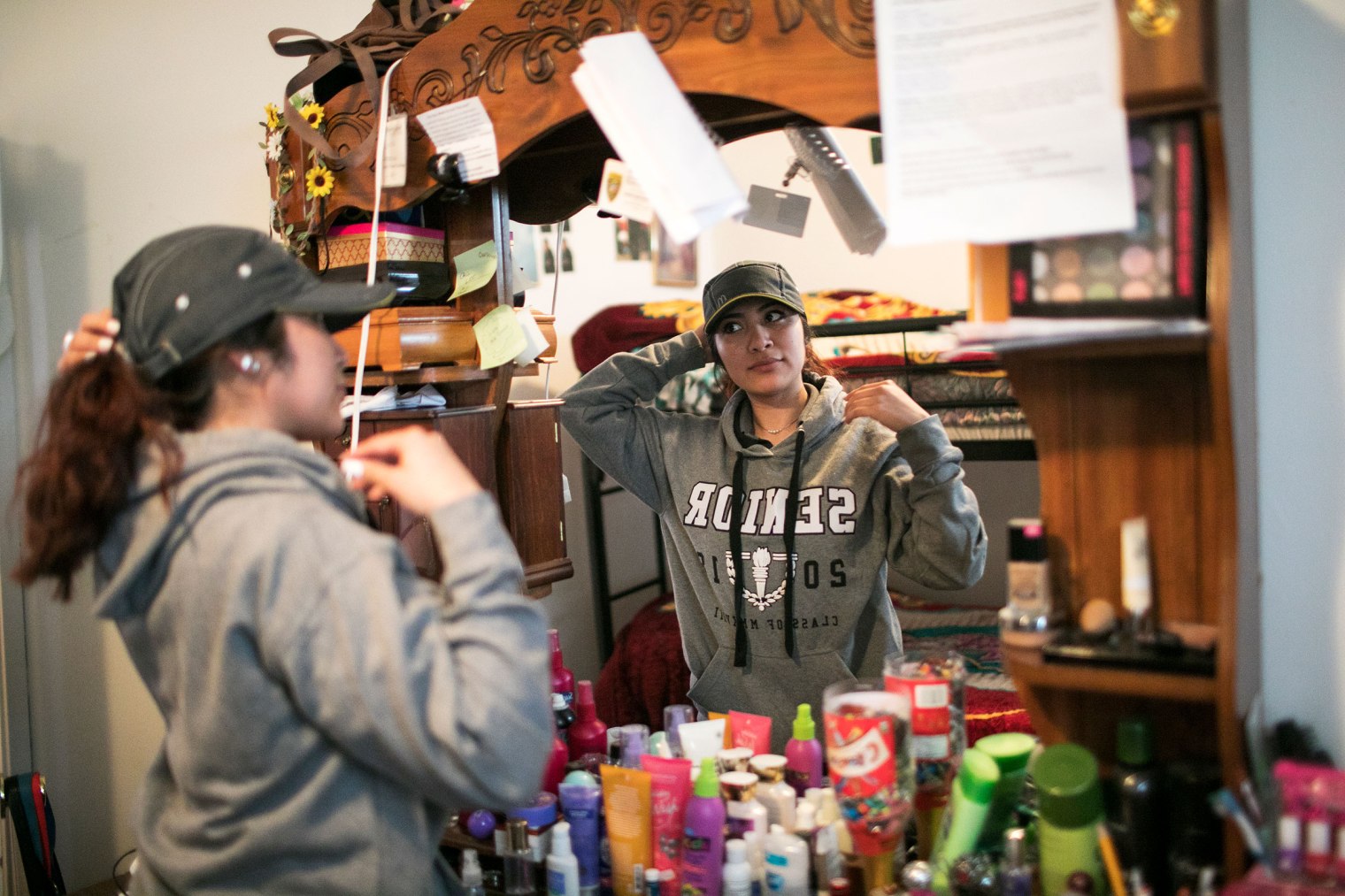 Barranco changes into her McDonald’s work uniform at home before her shift.
Barranco changes into her McDonald’s work uniform at home before her shift.
Barranco has been translating for her parents since she first learned English in kindergarten, shortly after she arrived in the U.S. Her father works in landscaping and her mother cleans houses. Neither of them finished middle school, and they speak only Spanish. Her father can write his name but not much else.
At 2 a.m. on July 28, 2012, Barranco got the phone call the family had been terrified of since they arrived. There had been a minor car accident; her father had been in the passenger seat. Nobody was hurt, but the Lorain police department asked to see his ID. He called his 12-year-old daughter to translate for him. “I told them, ‘No, he doesn’t have an ID, he doesn’t have anything,’” Barranco recalls. After she got off the phone, the police called federal immigration authorities. Barranco’s father was detained for nearly a week, but the church helped the family pay for a lawyer who was able to negotiate for him to be released. Since he wasn’t driving the car and hadn’t committed a crime, the case was eventually administratively closed, which means he’s not a priority for deportation.
The incident stuck with Barranco. She had always avoided cops, but she became even more scared after her father was detained. “Every time I heard sirens, I would start shaking,” she says. “My heart would start beating fast. I felt like a criminal just hearing them.” Worse was the guilt; as her father’s translator, she blamed herself for his detention. “I felt like I could have done something better,” she says. “I could have prevented them from taking my dad.”
In 2013, a year after Barranco’s father was detained, Chief Rivera went to a community meeting with immigration advocates. During his 47 years as an officer, including 24 years as chief of police, Rivera had paid close attention to the rising tensions between local communities and the officers who police them. He saw a growing mutual distrust in Lorain, where most of his police force is now from out of town. So he decided to create the Citizens Police Academy, a 10-week program to introduce ordinary citizens to police work. He had seen Barranco speak at local immigration meetings and heard she worked as an aide at her school library. He learned she was in the National Honor Society. So he invited her to join.
Every Thursday afternoon for 10 weeks last year, Barranco trained with the local police. She learned how to shoot a gun, how to use handcuffs, the proper procedure for drug investigations and arrests and the correct protocol for responding to a call. The first car she ever drove was a police car. The best part, she says, was learning how to use the siren. “I was so scared of that,” she says. “But now every time I hear it, I’m like, ‘Oh, they’re just coming to help.’”
Rivera is Barranco’s idol, so she’s excited to visit his office in the Lorain police headquarters. He keeps a figurine of the Statue of Liberty guarded by police officers on his desk, near a Blue Lives Matter mug and his official police hat. Rivera says Barranco “excelled” in the Citizens Police Academy program and that she would be a “gift to law enforcement.” He tells her he needs more officers who live in Lorain, who have deep ties to the community. He says her compassion would make her an excellent officer.
“So you think I can do it?” Barranco asks him.
“Absolutely. You can do it,” he says.
There is one snag, however. Under Ohio law, only U.S. citizens can become police officers. Rivera isn’t sure whether DACA students are eligible. “My heart would say yes,” he says. “But I guess I would have to check.”
One morning in late February, Barranco found a letter on her kitchen table informing her that she had been accepted to Lorain County Community College. The first thing she felt was relief. Then came a nagging question: How would she pay tuition?
LCCC offers free tuition to minority students who graduate from Lorain High with a good GPA. But Barranco’s DACA status created some hurdles. LCCC typically requires students to fill out the FAFSA so that the school only covers the costs left over after Pell Grants and other federal aid. A guidance counselor at her high school told Barranco that she couldn’t get the free ride unless she filled out the form.
That was a chance Barranco wouldn’t take. “I don’t want to risk myself,” she says. “Maybe the government will think I’m taking their money.” She resigned herself to using her McDonald’s money to pay the more than $8,000 per year it would cost to go to a college her classmates could attend for free.
But after inquiries from TIME, LCCC cleared up the confusion: because Barranco is not eligible for federal student aid in the first place, the school waived the FAFSA requirement for her and other DACA students. When an administrator called Barranco to tell her, she was shocked. “At first, I thought it was too good to be true,” she said. Then she asked if her friend Maria qualified as well. The next day at school, she stood a little straighter, smiled a little wider. “Now I feel like one of them,” she says.
All the while, life goes on. Congress keeps bickering over the fate of the DACA program. Trump keeps tweeting. And Barranco plods forward, one tentative step after another, toward what she hopes will be her American future.
Charlotte Alter is a National Correspondent for TIME.
